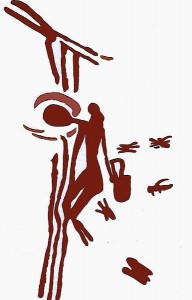"F. Marlowe and his research group have demonstrated that
the Hadza eat huge quantities of honey for months on end - something I've witnessed and participated in as well." - Jeff Leach, Founder of the Human Food Project, 12.23.14,
https://www.facebook.com/humanfoodproject/posts/774527309299502 
"In her ethnographic research on honey consumption, Crittenden discovered that
human hunters have long targeted bee hives. The artists who painted Altamira cave in what is now Spain some
25,000 years ago, for example, left depictions of bees, honeycombs, and—most amazing of all, in my opinion—honey collection ladders. And in Zimbabwe, archaeologists recorded a cave depiction of a human smoking out a beehive. San hunters and gatherers in the region told archaeologists that their ancestors had frequented the cave for nearly 10,000 years." - Heather Pringle, The Sweetness of Human Evolution, September 20, 2012,
http://www.lastwordonnothing.com/2012/09/20/the-sweetness-of-human-evolution"Upper Paleolithic rock art from Spain, India, Australia, and southern Africa all illustrate collecting honey. Altamira cave, in Cantabria, Spain, includes depictions of honeycombs, dated approximately 25,000 years ago. The Mesolithic Cueva de la Araña rock shelter, in Valencia Spain, contains depictions of honey collection, bee swarms, and men climbing ladders to get to the bees, at ~10,000 years ago.
Some scholars believe that collecting honey is much earlier than that, since our immediate cousins the primates regularly collect honey on their own. Crittendon has suggested that Lower Paleolithic Oldowan stone tools (2.5 mya) could have been used to split open beehives, and there's no reason that a self-respecting Australopithecine or early Homo could not have done that." - K. Kris Hirst, History of Honey Bees: The Human Management of Apis mellifera,
http://archaeology.about.com/od/hterms/qt/Honey-Bees.htm---*---

"hunting with the Hadza meant walking through brush, across savannahs, up hills and down escarpements from 7 am until 2 pm, which was a short day for them. We saw gazelles, wild boars and baboons, but didn’t catch anything. We’d be in the trail of gazelle, zebra, giraffe, ect., but our guides just kept getting sidetracked by honey! I guess its immediate and guaranteed food whereas the animals are much harder to catch." ("Living with the Hadzabe in Tanzania's Yaeda Valley,"
http://apvtravels.blogspot.com/2011/02/living-with-hadzabe-in-tanzanias-yaeda.html)
"Foragers in Latin America, Asia, Australia, and Africa include honey and bee larvae as major components of their diet. The Hadza hunter-gatherers of Tanzania, the population with whom I work, even list honey as their number one preferred food item!" - Dr. Elizabeth Gray,
http://www.thehadzalastofthefirst.com/2012/07/30/alyssa-crittenden-how-honey-helped-to-make-us-humanFrom "
Sex Differences in Food Preferences of Hadza Hunter-Gatherers" (2009. 7(4): 601-616,
http://www.epjournal.net/wp-content/uploads/EP07601616.pdf):
> “The most highly prized components of the Aboriginal hunter-gatherer diet were the relatively few energy-dense foods: depot fat, organ meats, fatty insects and honey” (O’Dea, Jewell, Whiten, Altmann, Strickland, and Oftedal, 1991, p. 238)
> Honey is the most energy dense food in nature (Skinner, 1991), and is highly prized by the Hadza. Honey combs often contain small amounts of bee larvae, which the Hadza consume along with the comb.
> Both males and females ranked honey first [in terms of preference]...
> ethnographers often claim that meat is the most preferred food among foragers (including the Hadza) (Bunn, 2001), yet our empirical data on individual preferences demonstrates that
honey is more preferred than meat among the Hadza.
---*---
"The story of Beowulf includes a Mead-Hall called Heorot that was so big and had so much attendant laughter that the monster Grendel broke in and slaughtered the noisemakers."
http://en.wikipedia.org/wiki/Mead_hall"This Estland [Estonia] is very large and has many fortified settlements, and in each of these there is a king. There is a great deal of honey and fishing." - Wulfstan, Two Voyagers at the court of King Alfred, trans. by Christine E. Fell (York, 1984).
https://classesv2.yale.edu/access/content/user/haw6/Vikings/voyagers.html---*---

Gurung honey hunter of Nepal with a load of honeycomb.

Raji nomad of Nepal gathering honeycomb.
Of course, we cannot assume with certainty that just because our Paleo-ancestors and other peoples ate a food that we can eat it without ill effects today. That would be blind Paleo re-enactment, which I reject. The evidence we have about the diets of our ancestors are clues, rough templates, starting points, rather than detailed prescriptions for optimal diets today.
Jeff Leach reported in a presentation I attended that the Hadza he shared honey feasts with did not suffer any signs of diabetes. He said most of them did clean their teeth often with the twigs of certain trees.
I have seen multiple reports from researchers in the field that obtaining honey from small trees normally requires no more expenditure of calories than hunting game. When the trees are not huge, my guess is that the calorie expenditure is actually less. Thus, it's no surprise that honey provides the highest net energy return of any food in the wild.
"Honey is the most energy dense food in nature. It is therefore notsurprising that, whereitexists, honey isan important food for almost all hunter-gatherers. Here we describe and analyze widespread honeycollecting among foragers and show that where it is absent, in arctic and subarctic habitats, honey beesare also rare to absent." https://www.academia.edu/9180464/Honey_hunters_and_gatherers_and_human_evolution
As Sabertooth perceptively noted: "Hunter-gather paleolithic man in [his] prime must have had a [superb] enzymatic capacity to devour and metabolize large portions of honey intermittently." And as Jeff Leach noted above, "intermittently" can mean nearly ever day for months at a time in season during plentiful years. For a HG to eat his fill, in season, of raw honeycomb and grubcomb, instead of just a smidgeon or two, would be quite "Instincto/Instinctive."
